Come learn along with me as I take a deep dive into the decluttering techniques of The KonMari Method & The Clutter Cycle in the categories of PAPER, BOOKS, AND CLOTHING.
First, I’ll introduce you to The Clutter Cycle, my clutter theory, which is an explanation of why we never catch up on decluttering and housework.
Next, you’ll view the KonMari Method through the eyes of Mandy Yang, a passionate, certified KonMari Consultant.
Let me explain. I’ve written a synopsis of Mandy’s professional view of the KonMari method via her online interview with Desirae Endres, the sweet host of the Minimal-ish Podcast.
Finally, I’ll tell you my personal opinion of The KonMari Method as I declutter my books, paperwork, and clothing using Marie Kondo’s book, “The Life-changing Magic of Tidying Up.”
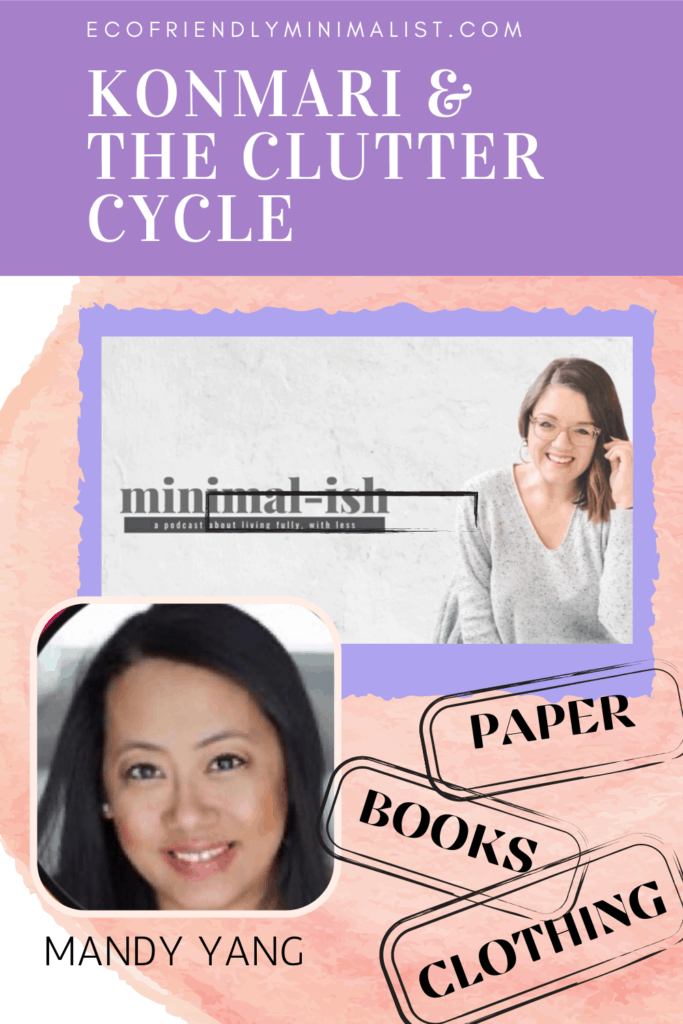
(Clickable Table of Contents)
- The Clutter Cycle – An explanation of why you'll never catch up on decluttering
- THE TRUE CAUSE OF DAILY CLUTTER
- How many people are living in your home?
- THE CLUTTER CYCLE
- Shopping Creates Clutter & Work for You!
- Shopping at Grocery Stores Saves You Money & Work
- Daily Systems Simplicity Plan:
- How Are Others Doing It?
- Minimal-ish, Among all of this, and KonMari
- Minimal-ish Podcast
- Desirae's Take On Minimalism
- Mandy Yang – Among All Of This (Website)
- Desiree & Mandy Inspired Me To Try The KonMari Method Again
- Three similar categories – Clothing, Paper, & Books
- Synopsis of Mandy's Interview with Desirae
- Books and Magazines
- Your Books Tell A Story
- konMari Method – Books
- THE CLUTTER CYCLE – BOOKS
- ECO-FRIENDLY ALTERNATIVES TO BUYING NEW BOOKS
- I LOVE AUDIBLE.COM! – (eco-friendly)
- KonMari Method -Papers –
- THE CLUTTER CYCLE – PAPER REDUCTION METHOD
- CANCEL MAGAZINE SUBSCRIPTIONS OR SWITCH TO DIGITAL
- KonMari – Clothing
- The Clutter Cycle – Clothing System
- IN CONCLUSION
The Clutter Cycle – An explanation of why you’ll never catch up on decluttering
I had been decluttering and purging my house for years but it didn’t seem to be making much difference.
Later, I discovered the concept of ‘minimalism’. I was on my minimalist journey when, overnight, I became homeless (see my mudslide story here.)
Without ninety-nine percent of my belongings, I discovered that “minimalism†isn’t achieved simply by owning less stuff.
While homeless, I learned the TRUE CAUSES of daily clutter and overwhelm which I call, The Five “Active†Causes of Clutter, and I created The Clutter Cycle, an explanation of why we feel like we never catch up on decluttering and remain feeling defeated.
THE TRUE CAUSE OF DAILY CLUTTER
Spoiler Alert: “Active” Clutter is caused by daily living activity: eating, bathing, and dressing. That’s it, folks.
Add paperwork, garbage, and recycling and you now have the BASICS OF DAILY CLUTTER AND OVERWHELM.

DAILY LIVING IS ‘ACTIVE‘
It is constantly moving and changing.
DAILY LIVING CREATES
DAILY WORK and DAILY CLUTTER.
Many of the things in your bedroom, bathroom, & kitchen will be used every day.
How many people are living in your home?
I can make a big mess all by myself, every day. Add one other person, say another adult. Add a kid, maybe two. You get my point.
Your workload is now exponential. Will all of those extra people pick up after themselves? Probably not.

THE CLUTTER CYCLE
If you look at The Clutter Cycle below, you can see the true reason for feeling defeated and overwhelmed:
- SHOPPING
- It is required weekly; we have to eat, right?
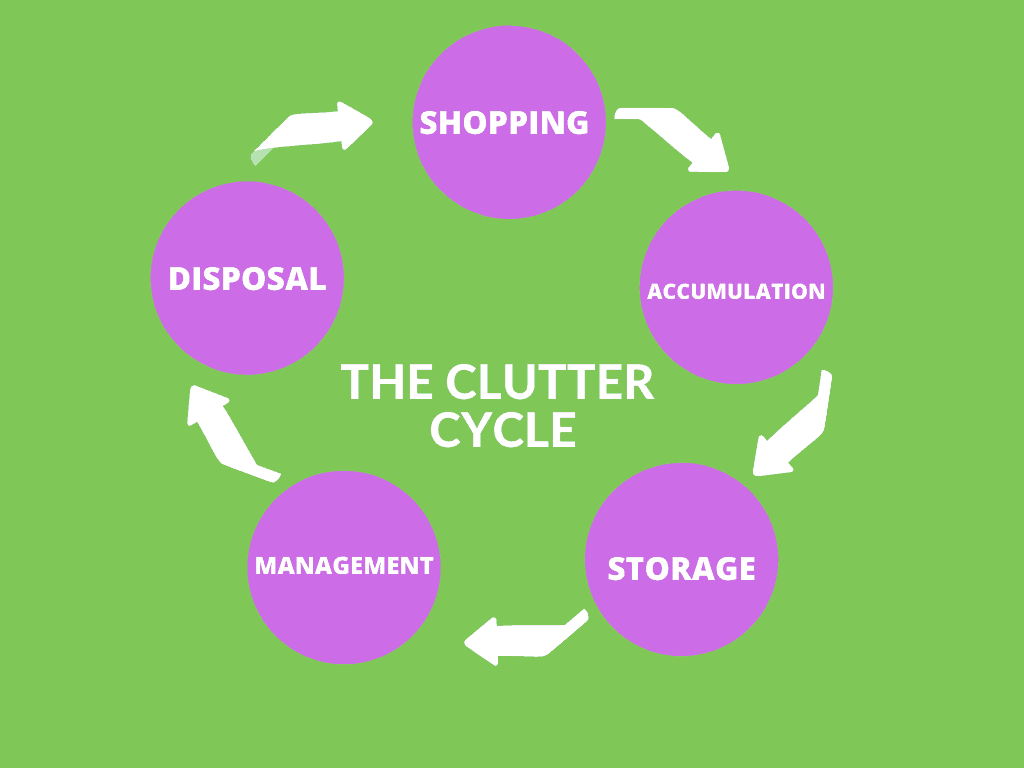
Shopping Creates Clutter & Work for You!
If you’re shopping at Target, Costco, or other big box stores, it is highly likely that you are buying lots of other things besides food!
Managing groceries is hard enough, but when you have a system where you are constantly bringing in excess, it creates an accumulation of stuff that you now have to store, manage, and eventually dispose of.
The biggest problem is that we don’t have routines and rituals to purge our accumulation of stuff!
So it all piles up and creates a lot of stress and work us!
Didi
Also, we get emotionally attached to our stuff and can’t seem to let it go.
Don’t get me wrong. I get that shopping is fun too! Plus, it gets you away from the house and stimulates some of those good old endorphins!
But, take a look at what it can create! Ugh!

Shopping at Grocery Stores Saves You Money & Work
Shopping at a grocery store is the best idea because you don’t have the opportunity to buy excess stuff.
You also won’t need to use any extra decision-making or willpower skills. It’s a win-win!

The Real Real!
Here is a recent post from the Website Becoming Minimalist, written by Joshua Becker, titled, 17 Staggering Statistics about our shopping habits. The first statistic in his article states:
1. The average woman makes 301 trips to the store annually, spending close to 400 hours a year shopping. This amounts to 8.5 years spent shopping during a typical lifespan. (NY Daily News)
Daily Systems Simplicity Plan:
Food, Clothing, Personal Care, Paperwork, & Recycling Systems
Not sure where to start organizing? You can simplify your daily life by starting to reduce, plan, and manage these daily systems first!
REDUCE – PLAN – MANAGE – PURGE
START REDUCING
PLAN TO CHANGE YOUR HABITS
MAKE A MANAGEMENT PLAN FOR UPKEEP
MAKE A REGULAR PURGING PLAN
How Are Others Doing It?
My favorite thing is to connect with other people and hear their stories.
Didi
Minimal-ish, Among all of this, and KonMari
As a minimalist entrepreneur, I’ve sought out so many different methods to achieve my minimalist dreams. I’m always looking for new and interesting people and ideas.
Along the way, I have discovered many podcasts, but one that really speaks to me is called “Minimal-ish.â€

Minimal-ish Podcast
Minimal-ish is hosted by Desirae Endres, who has a sweet, soulful spirit, an ability to make her guests feel like long-time friends, and listeners feel like they’re part of the conversation.
She also seems to hit on subjects and ideas in a real and honest way. She tells you things that are personal, and maybe not-so-perfect. In this way, I can relate to her and I appreciate her honesty.
Desirae’s Take On Minimalism
The biggest hit for me, though, is that Desirae also understands that minimalism isn’t just about getting rid of stuff and that the act of getting rid of stuff can’t inherently make you happy.
Desirae was also enamored with the idea of minimalism and says that it changed her life, so much so, that she created a podcast called, “The Minimalist Family.â€
One thing led to another, and Desirae had this revelation (excerpts from her website):
“Social media made minimalism feel like a comparison game. It felt like it was all about decluttering and how little stuff you could own. The person with the least stuff wins!
But then I dug deeper and realized minimalism isn’t just about a tidy home and throwing all your stuff away. It’s about space. Space in your home but also space in your life. Space to breathe. Space to enjoy your people. Space to learn who you are and what you love. Space to actually do what you’ve been wanting to do.â€
Desirae decided to change the name of her podcast to “minimal-ish†and focus on all matters related to intentional living.
Besides discussing her own thoughts, Desirae interviews interesting women with varying views and experiences about life, including motherhood, relationships, and mindset. The interview archives on her website will keep you interested and busy for a very long time!
Mandy Yang – Among All Of This (Website)
On March 26, 2020, Desirae interviewed Mandy Yang of “Among all of this†(amongallofthis.com) to learn more about her experiences and knowledge as a KonMari Consultant Trainee and about the KonMari Method for decluttering your home.
Have you heard of The KonMari Method or Marie Kondo? Marie wrote a book called, The Life-Changing Magic of Tidying Up.
This book and her methods have become extremely popular around the world, including in the U.S., selling over three million copies.
Of course, as a minimalist wannabe, I have also followed Marie Kondo, purchased her books, and watched her Netflix series.
I have to say, though, the book and the Netflix series didn’t change my life or alter my habits in any significant way.
Desiree & Mandy Inspired Me To Try The KonMari Method Again
After listening to Desirae and Mandy discuss the KonMari Method, I thought it would be interesting to write about Mandy’s interpretation of The KonMari Method, and also to compare it with my theory of The Clutter Cycle.
In listening to the podcast episode (here), it is obvious that Mandy has more than a passion for The KonMari Method. She relays a pride and a deep belief in the theory and its ability to “change how you feel by changing your thinking.â€
Mandy believes that The KonMari Method can “change you, your home, and your values.â€
That’s pretty amazing! So, I decided to do a deeper dive into the KonMari Method.
While writing this blog post, I was inspired to try KonMari’s methods again. I have to say, they are effective.
Didi
Three similar categories – Clothing, Paper, & Books

Comparing The Clutter Cycle with the KonMari Method appealed to me because three out of five of the categories are the same.
So, I decided to intensively apply Marie Kondo’s recommendations for managing the three categories, clothing, paper, and books.
I have outlined her management plan for each category and I will also tell you how it worked for me, personally.
The rest of the categories (komono and sentimental) of the KonMari Method can be found by getting the book or watching the Netflix series. There are also dozens of people who have made YouTube videos on the subject.
Synopsis of Mandy’s Interview with Desirae
Mandy starts off by explaining that decluttering the KonMari way is more of a “reflective” process; it’s more mindful.
Mandy says that the Konmari Method is good for anyone who is overwhelmed and needs help to start the decluttering process. It is also good for people who are in transition, such as divorce.
She says that being present with people, and not things, is a goal that can be reached through this method.
Mandy relayed the idea that she would rather talk to her kids about their day than to be nagging them to clean up. I like that.
Additionally, she says that having a home that isn’t cluttered can make you feel calmer and, of course, your home will be easier to manage as well.
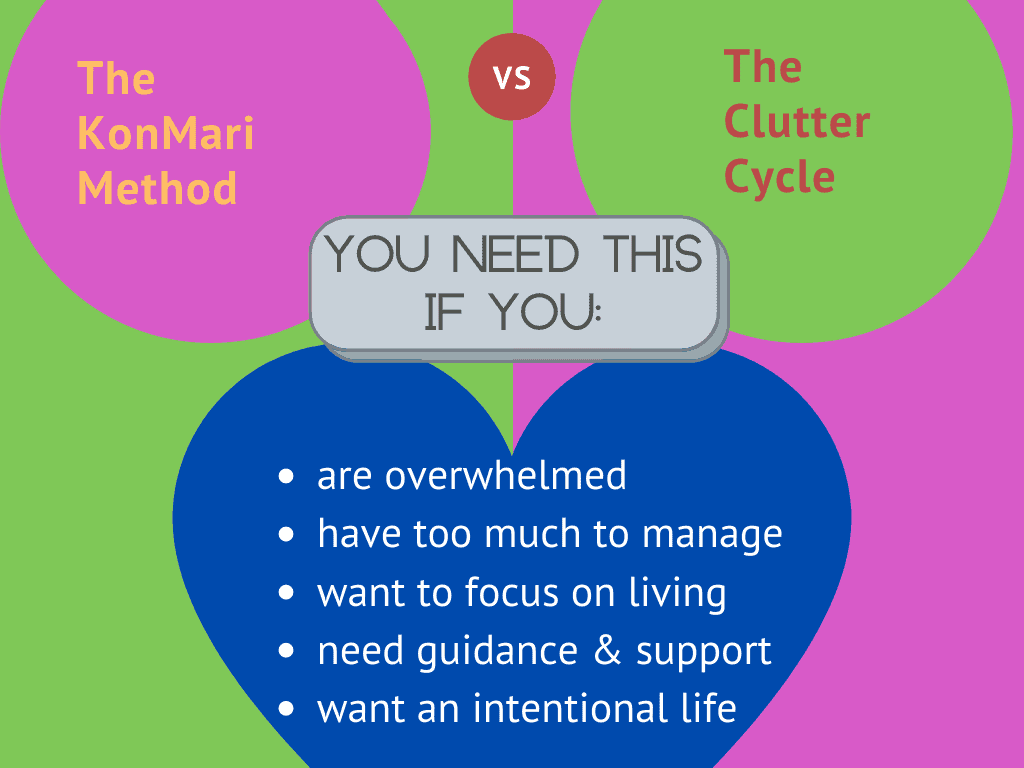
Mandy explained that the KonMari Method is different from other methods because you CHOOSE WHAT YOU WANT TO KEEP versus just getting rid of more stuff.
Mandy says that if you follow the method that it will help you to refine your thinking and decision-making skills because you are supposed to pick up every single item and assess how it makes you feel. Does it bring you joy?
I was able to let go of more things by thinking about how something made me feel instead of asking myself other questions.
Didi
Another difference is that the KonMari Method tidies by category and NOT location. The categories are set up to go from easy to difficult.
The Kon Mari method starts with the easiest category, which is your clothing, then moves to books, papers, kimono (everything else), and finally sentimental items.

The Kon Mari process is:
- GATHER
- SORT
- JOY CHECK
- STORE WELL
Mandy says that joy checking consists of two ideas revealed by asking yourself: Does this spark joy?
- Viscerally – how does it make you feel?
- Gratitude – If you need the item but it doesn’t necessarily bring you joy, you can then feel gratitude for having it and keeping it (Mandy suggests mixing bowls as an example).
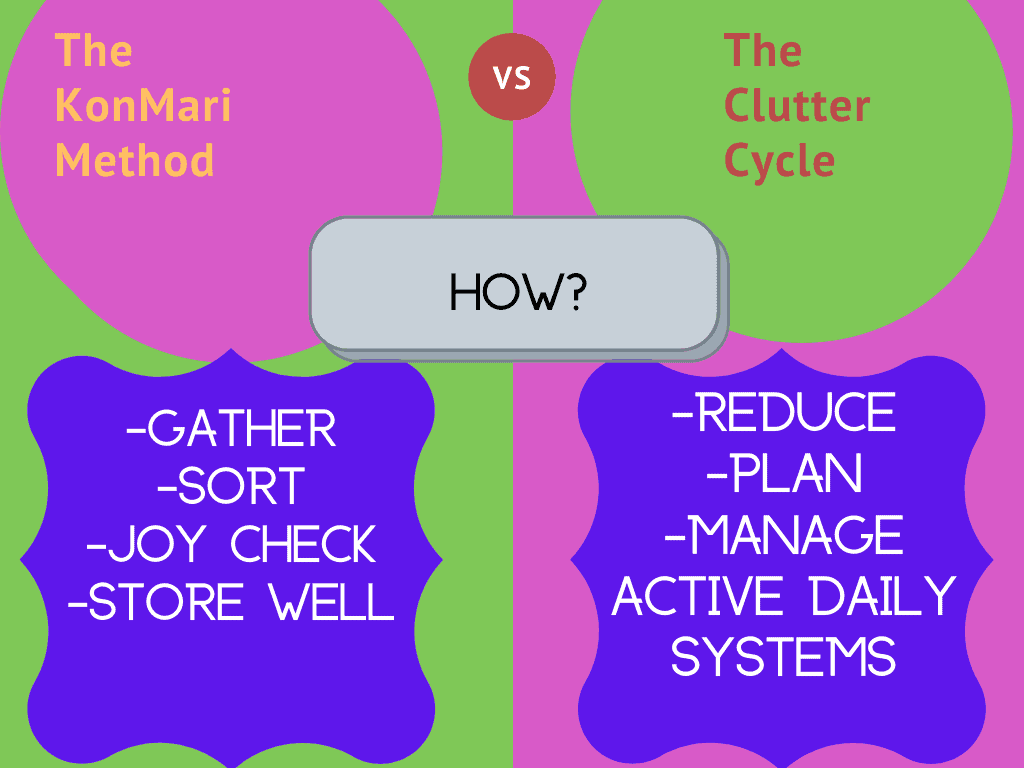
Be sure to listen to Desirae and Mandy on her podcast episode here!
Books and Magazines
Books are a tough category for a lot of people to let go.
When I think about my own book collection, I understand why. Everyone has their own reasons for buying books.
I know for myself, oftentimes I was looking for resources, knowledge, or just to understand the world from someone else’s perspective (someone wiser, presumably!)
Books can also be a way to connect with other people, a type of socialization.
Your Books Tell A Story
I have found my own book collection to be extremely personal.
I remember this incident:
In the days following the mudslide, (see my story here)I found myself feverishly trying to get rid of things because everything that wasn’t ruined had to be stored. We had about four days to get the remaining contents of our house boxed up.
I’ll never forget this day:
I don’t remember why, but there were about three rows of cardboard file boxes stacked five high in my garage. They were FILLED TO THE BRIM WITH BOOKS.
My neighbor, who was helping us pack up, was standing over my shoulder as I quickly browsed through the boxes.
I was just too overwhelmed to make any decisions and he offered to take them to his house and take care of it for me. I agreed. I never saw the books again.
However, I do remember feeling like he had just learned A LOT about me. I felt embarrassed, exposed, and vulnerable.
Woe is me! 🙂
Didi
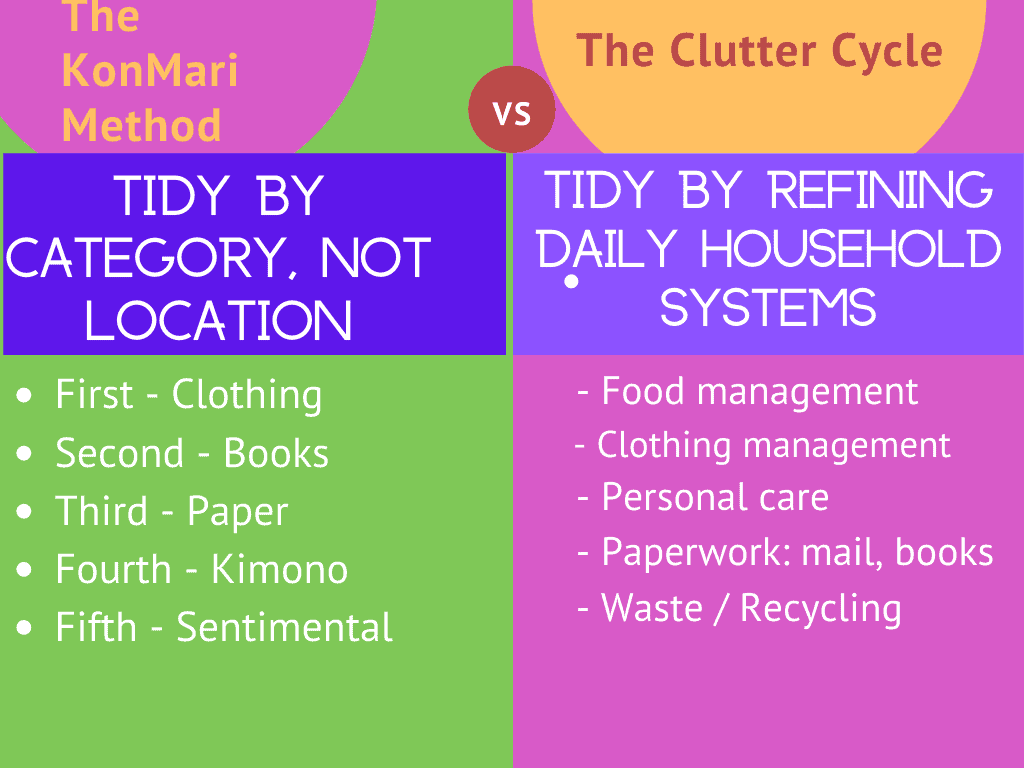
konMari Method – Books
These notes are taken directly from her book, “The Life-Changing Magic of Tidying Up”.
Marie Kondo’s method is to gather all of your books and put them together in one place. She insists on this method, no matter how many books you have.
This was overwhelming, but also empowering. It helped me to see the volume of books that I had.
Didi
Marie believes that you need to touch each book in order to make a decision whether to keep it or not.
She says the books are dormant if they haven’t been touched in a long time. She believes they become conscious once you pick them up and bring them to life.
Pick up each book and ask yourself, does this spark joy?
This method worked well for me in certain categories of my books.
I decided to keep the “joy” books in a separate bookcase so that it held more excitement and creative energy that I would want to access often.
My resource books went on a bookshelf in another room.
Didi
Marie says to ask yourself: does it give you a thrill of pleasure when you touch it?
She also advises: DO NOT OPEN THE BOOK AND START READING. THIS IS A DISTRACTION.
I chose to take my time looking through my books, so I opened them and looked through the table of contents.
This helped me to compare my books that were on the same subject matter and decide which ones I wanted to keep.
I did end up being more overwhelmed, though, because it took me two days.
Didi
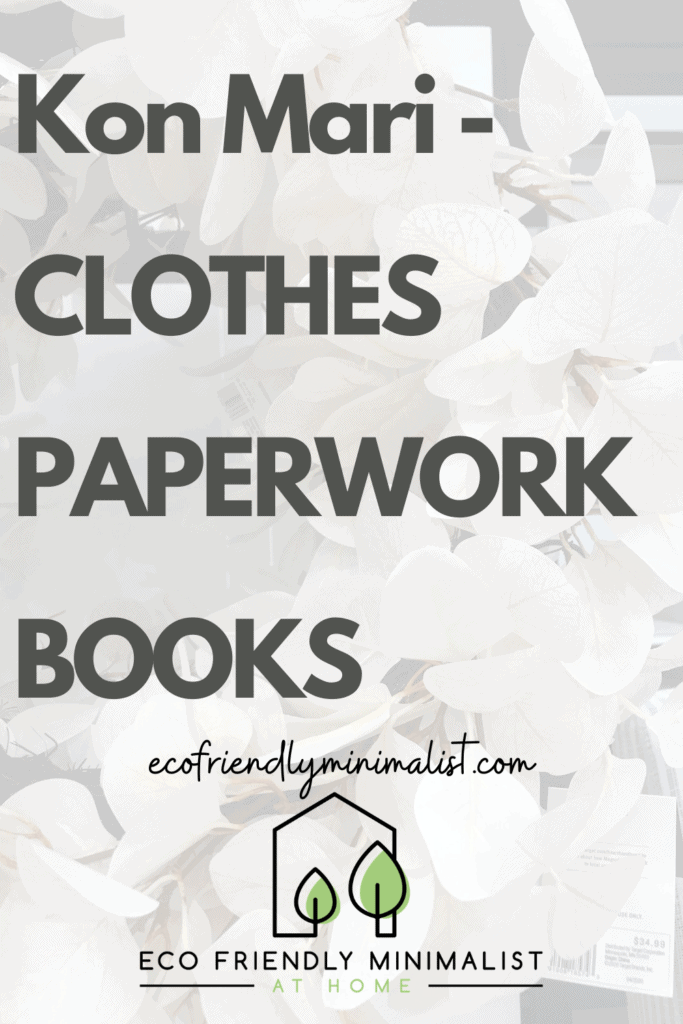
OTHER KON MARI METHOD RULES FOR BOOKS:
UNREAD BOOKS: You probably will never read it.
BOOKS YOU HAVE STARTED READING: These are harder to part with. Marie says, “you will probably never read it”. This is your chance to let it go. Read the books you’re interested in now.
If I had started reading a book and didn’t continue to read it, this meant that it didn’t hold my interest.
I was able to let these go easily.
Didi
Marie says,
“Keep only the books that will “move” you to see them on your bookshelves; the ones you really love. No joy = discard.”
I did try to keep in mind which books I wanted in my present and future life.
Didi
Marie: REFERENCE BOOKS: If you haven’t read it yet, let it go. By discarding it, you will learn how passionate you are about learning the subject and you can get another book from the internet.
I had a lot of reference books from the same category.
I really did want to let them go, and I did let go of quite a few, but I couldn’t force myself to get rid of all of them.
Since I have space, I put them in another room on a built-in bookshelf.
They are mostly health-related books. I tended to keep the books that were written by trusted authors.
I do feel that by having fewer books that I might look at them more often.
Didi
Marie believes that timing is important and that when you obtain a book is when you should read it.
She also believes that you should keep your collection small.

THE CLUTTER CYCLE – BOOKS
I believe that you should keep all of the books that make you happy as long as you have bookshelf storage for them.
If you don’t have space, then it’s probably a good idea to let some books go.
However, I did have A LOT of books and I thought that if I tried the Kon Mari method that it might help me to feel a little more free and light.
In the end, I think it was a good move for me to purge and update my book collection.
Didi
The Clutter Cycle theory is a Reduce – Plan – Manage -Purge system.
Part of the ‘reduction’ idea is to change the way that you consume books:
- Move from buying physical books to audiobooks or digital formats, or
- Start using your local library, or
- Switch from buying new books to buying used books
ECO-FRIENDLY ALTERNATIVES TO BUYING NEW BOOKS
Check out books from the library
Well, here’s an old tried and true method of consuming books without having to store them!
If you get a book from the library and you absolutely love it and want it on your bookshelf, then you can choose to buy it.
Buy Used Books (eco-friendly)
Buying used books from the library, thrift stores, or even Amazon and eBay, would be the next best choice.
Used books on Amazon and eBay are extremely inexpensive because there are so many people selling books.
You can easily get a book in great condition for less than five dollars.
This post contains affiliate links, which means I receive a small commission, at no extra cost to you, if you make a purchase using this link. Please see my disclosure for more details.â€
E-READERS – GO DIGITAL (eco-friendly)
- Switching to digital e-readers is an option that many people like.
- Many different brands of e-readers can be found on Amazon.
- An e-reader (electronic reader) is a small, flat device that looks like an electronic pad (see photo below)
- The link below is for a Kindle e-reader.
- Many libraries have digital Ebooks and audiobooks that you can check out for free!


I LOVE AUDIBLE.COM! – (eco-friendly)
- With audiobooks (AUDIBLE.COM) you can LISTEN to books on your phone, computer, or other devices.
- Many audiobooks are read by the author. I love that!
- When the author reads the book it adds a personal dimension that you cannot get from interpreting the book in your own voice.
- I have over 200 books in my Audible library! I certainly don’t have room for that many books in my home!
- Also, if you don’t like a book, Audible lets you exchange your credits.
Some facts about Audible.com
- Audible is an Amazon Company. They sell audiobooks.
- You can get your first 30 days free.
- After 30 days, you can continue with Audible for around $14.95 per month, of course, prices are subject to change.
- You can cancel online anytime.
- You get one credit per month for any title regardless of price or length.
- You can upgrade your plan if you want more than one credit (equals one book) per month.
- If you don’t like your book, you can exchange it for another one.
- Audible gives you a lot of FREE CONTENT as well, including free select Amazon originals, free guided wellness programs with exclusive meditation and fitness programs, and free major US newspapers delivered straight to your audible library.
e-reader vs audio-books
An audiobook is kept on your phone or computer as an audio file. The book is read aloud to you by either the author or a narrator.
An E-reader is a small, lightweight tablet device that holds your books on digital files. You will physically read the book much like a regular paperback book.

KonMari Method -Papers –
Paper, paper, paper! Paper has plagued my life!
Didi
As I listened to “The Life-Changing Magic of Tidying Up,” I became intrigued with Marie Kondo’s method for handling paperwork. Basically, she doesn’t believe that we should even have a home paper filing system!
I think that maybe life in Japan might be different, but in America, I feel like, “my life is an office job!” It makes me soooo mad!!!
I can NEVER catch up on my paperwork! I’ve been trying for years!!! With every method that I have tried, and I’ve tried them all, I have never once found a method that works for me!
The paperwork continues to pile up!
I have worked EXTREMELY HARD TO FOLLOW MARIE KONDO’S PAPERWORK SYSTEM. While I have mastered her “system” I have not mastered an empty in-box.
I found her plan to be extremely difficult and frustrating, but I was determined to understand it and make it work.
Because it was so difficult for me, I nearly wrote her instructions ” verbatim.”
All notes are directly from Marie Kondo’s book: “The Life-Changing Magic of Tidying Up”.
Rule of thumb – discard everything
Marie Condo
Marie says that the people she has worked with generally have A LOT of paper and that some people are very efficient with their systems.
But, Marie HATES filing papers and doesn’t believe that we should need to have filing systems for the home.
Gather paper from EVERYWHERE in the house
- Gather all paper to one area and sort through everything.
Her basic principle is to throw everything away. She says that paper never inspires joy.
However, she goes on to discuss the following categories that should be used for the initial sorting process.
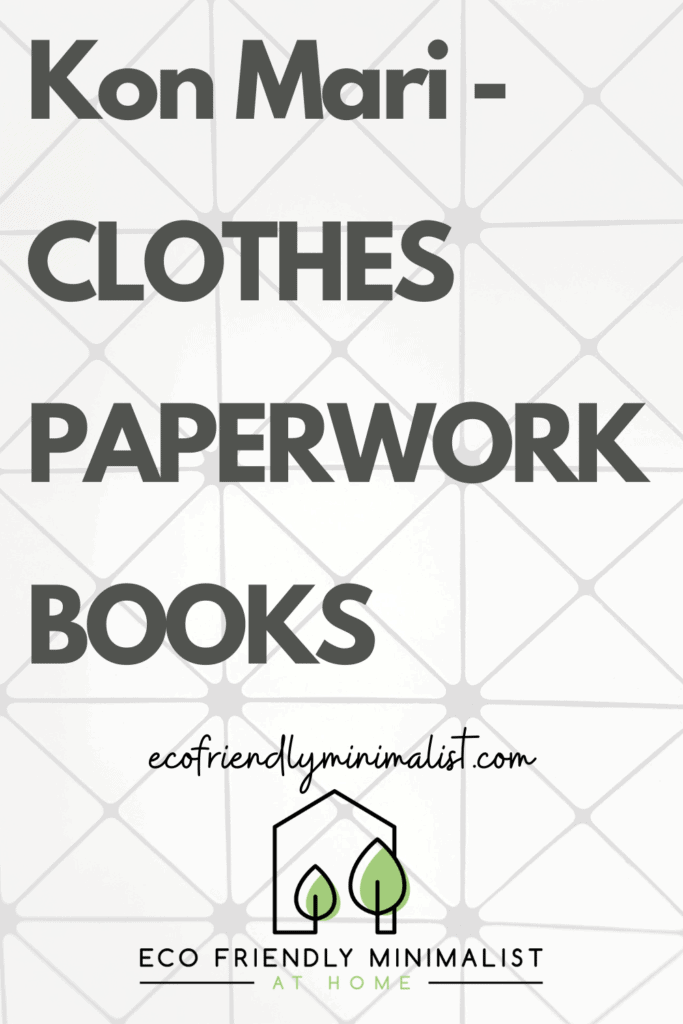
Sorting guidelines: Dispose of anything that doesn’t fall into these three categories:
- CURRENTLY IN USE
- NEEDED FOR A LIMITED TIME
- MUST BE KEPT INDEFINITELY
CAUTION: DO NOT try to sort sentimental papers at this time. Letters, diaries, and anything that evokes an emotional response should be saved for last.
I have worked so hard, for weeks, to understand this system and break it down.
The reason, as you’ll see, is that Marie Kondo begins by telling us to throw everything away and that we don’t need a home filing system, but then goes on to guide you through literally THREE DIFFERENT SETS OF CATEGORIES.
I made a chart just to sort it out in my head. The chart is below and is titled, “Kon Mari Paper Organization Chart.”
Didi
What you should do with the papers you’ve decided to keep? Marie Kondo’s simple (her words) filing method:
DIVIDE ALL PAPERS INTO TWO CATEGORIES:
- PAPERS THAT NEED TO BE DEALT WITH
- PAPERS TO BE SAVED
Again, she reminds us that her policy is to get rid of all papers, these are the only categories she makes for those that can’t be discarded.
papers to be dealt with:
- Includes letters requiring a reply, forms that need to be submitted, a newspaper that you intend to read.
Wait, she puts newspapers under “papers to be saved (frequent)” too!
I’m confused!
Didi
- She suggests that you make a special area for these types of papers and make sure to keep them in one spot only.
- Don’t let them spread to other parts of the house.
- All papers requiring attention can be placed in here without separating them.
Okay, so basically, her ‘papers to be dealt with‘ category includes all action items, I’m supposing, including your bills.
I always keep my bills in a completely separate place so that I don’t have to sort through a mound of papers to find them.
Didi
Papers to be saved
Okay, two more categories!
Didi
Subdivide according to the frequency of use:
SUBDIVIDE THE ‘SAVE’ CATEGORY INTO TWO:
- Infrequently used (insurance policies, guarantees, and leases.)
- No effort is needed to store these types of papers because you will probably never have to access them.
- She recommends putting them into a single clear plastic folder without further categorization.
- More frequently used – (outlines of seminars, newspaper clippings, etc.)
- Try to make these easily accessible so that you will look at them.
- She recommends putting these into the booklike pages of a clear plastic file folder.
- These are the papers that multiply easily and that we should be trying to reduce.
- Reducing the volume of this category is key to organizing papers.
What!? Three more categories?
Oh, no. . . her point is that YOU ONLY NEED THESE THREE CATEGORIES IN TOTAL. OK.
Didi
Papers are organized into only three categories.
- Needs attention
- Should be saved (contractual documents)
- Should be saved (others)
The point is to keep all papers in the same container or folder and to purposely refrain from subdividing them any further by content. In other words, you only need three containers or folders.
Don’t forget that the ‘needs attention’ box should be empty. If there are papers in it, you have left things undone that require your attention. Your goal should be to aspire to empty it.
You can be the judge on how confusing that was, BUT, I made you this nice chart (below) to try to organize her ideas.
Didi
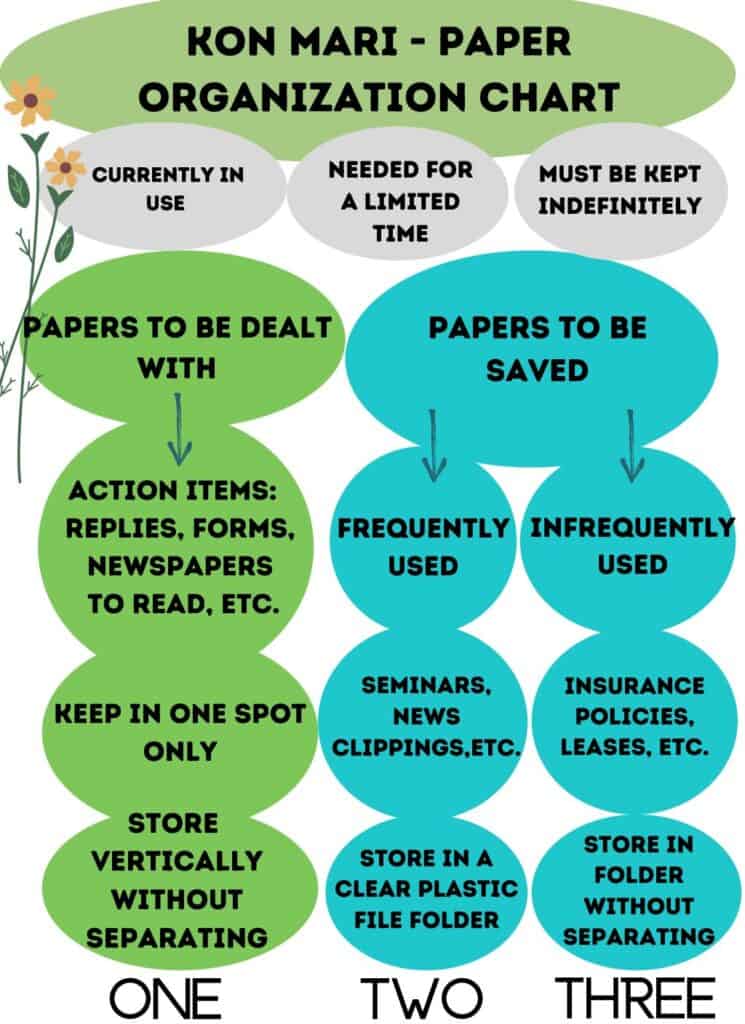
Troublesome Papers – How to Handle
Lastly, Marie Kondo gives you these additional directives:
- Lecture materials from seminars can pile up and make indoor space feel oppressive, like an office. Additionally, most people never touch the handout materials again. It’s best to change your thinking about the seminar; think of it as an experience and let go of the paperwork. Apply the learning right away, or it will be wasted.
- Credit card statements – After you’ve checked the statement you can discard it.
Unless you need it for your taxes.
Didi
- Bank withdrawals slips and statements – toss after checking
- Warranties – file in one clear file folder without categories – discard the manuals.
- Greeting cards – toss after reading (and appreciating) Only save one envelope for the return address.
- Used check books – toss
- Pay slips – check and toss
THE CLUTTER CYCLE – PAPER REDUCTION METHOD
OKAY!!! So now my turn! The Clutter Cycle method is based on a REDUCE, PLAN, MANAGE ideal.
Below are some ideas for trying to reduce the amount of mail that comes into your mailbox every day.
The methods suggested below actually DO WORK! I have been so pleased with my results. The mail coming to my mailbox every day has been dramatically reduced! (But I still can’t get my inbox to zero or even close!)
REDUCE INCOMING MAIL
- Place a “NO ADVERTISING MATERIALS†sign inside your mailbox.
- If that doesn’t work, check with your local post office to learn how to manage advertisements.
- Unsubscribe or cancel catalogs that you receive in the mail, or ask to receive them digitally.
Use A Mail Preference Service
I have done this and it has reduced my incoming mail a lot! It’s definitely not 100% effective though, and it’s not a panacea, but well worth the time, effort, and the $2 for ten years.
If you want to start managing the mail you or anyone in your household receives, you can go the website called, DMAchoice.org.
This is called a mail preference service.
Direct Mail Options
DMA helps you to choose exactly what direct mail you want to receive.
Catalogs
- They supply an extensive A-Z list of catalogs that you can choose from: which you want to receive and which ones you DON’T.
- Example: A – American Girl Brands
- B – Bed Bath and Beyond
- W – Williams-Sonoma Home
Magazine Offers
- They offer an A-Z list of magazine offers for you to choose from.
- Example – A – American Baby
- B – Better Homes and Gardens
- V – Vanity Fair
Other Mail Offers
- Again, they supply an extensive list from A-Z for other mail offer options.
- Example: A: Ace Hardware Corporation,
- B: Best Western International
- U: Unicef
- They say to allow 30-90 days for changes to take full effect.
- They say that the fastest way to stop receiving catalogs is to contact the companies directly.
How to Sign Up for DMAchoice (Note: $2 fee)
- HOW DO CONSUMERS REGISTER FOR DMAchoice?
Online registration:
Consumers can register at DMA’s consumer website: www.DMAchoice.org for a processing fee of $2 for a period of ten years. Registering online is the fastest way to see results.
Mail-in registration:
If you do not wish to complete your registration online, you can register for DMAchoice by using the mail-in form that is online: fill out the DMAChoice Mail In Form with all required information, print it, and mail to the address below.
Or, if you do not have access to the Internet, you can register by sending your name and address (with signature), along with a $3 processing fee (check or money order payable to DMA) to:
DMAchoice
DMA
P.O. Box 900
Cos Cob, CT 06807
Halt Credit Card Offers!
Taking this step has dramatically reduced my incoming mail by NOT receiving multiple credit card offers every day that I would then have to shred.
I used to toss them in a brown bag (for shredding). The bag would literally fill up!
Didi
OptOutPrescreen.com:
This is a joint venture between Equifax, Experian, Innovis, and TransUnion, which are credit reporting companies.
Visit that site to Opt-out of receiving credit card solicitations by mail.
They give you two choices: You can opt out of receiving them for five years or opt out of receiving them permanently.
To opt out for five years: Call toll-free 1-888-5-OPT-OUT (1-888-567-8688) or visit www.optoutprescreen.com. The phone number and website are operated by the major consumer reporting companies.
To opt out permanently: You may begin the permanent Opt-Out process online at www.optoutprescreen.com. To complete your request, you must return the signed Permanent Opt-Out Election form, which will be provided after you initiate your online request.
If you don’t have access to the Internet, you may send a written request to permanently opt out to each of the major consumer reporting companies. Make sure your request includes your home telephone number, name, Social Security number, and date of birth.
Experian
Opt Out
P.O. Box 919
Allen, TX 75013
TransUnion
Name Removal Option
P.O. Box 505
Woodlyn, PA 19094
Equifax, Inc.
Options
P.O. Box 740123
Atlanta, GA 30374
Innovis Consumer Assistance
P.O. Box 495, Pittsburgh, PA. 15230
CANCEL MAGAZINE SUBSCRIPTIONS OR SWITCH TO DIGITAL
- Read magazines online instead, or;
- Borrow magazines from your library
HOME OFFICE
- Don’t PRINT.
- Try to keep as much data as possible on your computer.
- PAY BILLS ONLINE
- Most banks offer a free Bill Payment service.
- You can also sign up with individual service providers (like your utility company) to pay your bills automatically.
- RESIST THE URGE TO PICK UP FREE PRINTED MATERIALS like brochures, newspapers, etc.
Okay, so that was a lot of detail. You can screenshot anything that you want to save, or look for my free checklists at the end of this post.
KonMari – Clothing
I took the time to do this well and I have to say, it has been AMAZING! Doing my laundry has gotten so much easier, and my closet DOES NOT pile up with worn clothing or dirty laundry in the same way that it used to.
I highly recommend taking the time and effort to do this well. If you are nervous about getting rid of too many clothes, then put them somewhere else, just as an emergency measure.
Didi
Note: The information presented here is taken directly from her book, “The Life-changing magic of tidying up.”
Place every item of clothing on the floor.
- Be sure to get every single item of clothing that you own. Marie says that this step is critical.
- She actually has a punishment system set up for her clients, whereby anything that isn’t included will automatically be discarded.
- Marie says that it is typical for many of her clients to have gathered an average of 160 tops.
- Keeping this figure in mind may help you to see how your piles compare.
Marie suggests to start with off-season clothes and ask yourself:
Does this spark joy?
Marie Kondo
You can also ask yourself:
- Do I want to see this outfit again?
- Would I want to wear it again right now?
- If not, express appreciation for the item and let it go.
Marie says to make sure to handle each item
I started the Kon Mari clothing system when it was time to do my laundry because that’s when there are usually very few items left in my closet (since they’re all in the hamper.)
This is also a good time to clean out your closet and take a look at the clothes that are left in your drawers and ask yourself if you like those items or question why you’re not wearing those items.
I followed the Kon Mari method moving everything out of my closet which I don’t really like doing.
However, after removing everything from my closet, I was surprised by the good feelings that I got from starting out fresh with a clean, empty space.
Marie Kondo suggests using your closet for other items, especially if it’s a deep closet but I am adamantly against that idea.
I like to keep only clothing in my closet and I try to bring ALL of my clothing to that one space.
I have about four drawers in my closet, so I don’t have clothes in any other dresser.
I suggest putting dressers or other drawers either in the closet or as close to the closet as possible.
Didi
KonMari’s Other Advice
Loungewear
Marie says that saving clothes that you don’t really like and changing its use for loungewear is a bad idea. It’s just a delay tactic for getting rid of clothes that aren’t working for you. Marie suggests that you should wear actual loungewear that is made for comfort and lounging.
Pajamas
Marie suggests that you should upgrade your pajamas to be very nice so that you are showing yourself respect and you look nice.
- Do not wear junky pajamas! This should give you an idea of what to toss.
Storage
By this time, she says that you should have about one fourth to one-third of the original amount of your clothing left.
KONMARI’S TWO METHODS of Storage – Hanging & Folding
- Marie believes that folding is better for saving space.
- She stresses that folding clothing is steeped in rich Japanese tradition, and this may explain her interesting (and frankly, odd) ideas about folding clothes.
- Marie likes folding clothes better than hanging but admits that some items of clothing like to be hung rather than folded.
- She tends to personify clothing and suggests that you should think about how the clothing might feel.
- Also, she says that when you fold each item, you have to engage with it, putting your heart into it while at the same time thanking the item.
HOW TO FOLD
- Imagine the size of the drawer where the clothes will be stored
- Goal: to fold each piece of clothing into a smooth rectangle
- First, fold each lengthwise side of the garment toward the center
- Tuck the sleeves in to make a long rectangular shape.
- Pick up the one short end of the rectangle and fold it in towards the center.
- Fold to make the standing item fit the size of the drawer.
- Stack the clothes side-by-side so that you can see the top of each item.
KonMari – How to Arrange Clothes
Marie thinks that hanging certain items of clothing are better than folding, such as:
- coats
- suits
- Jackets
- skirts
- dresses
She says to hang anything that would be happier hung, like flowing fabrics.
KonMari – Organizing hanging items
Marie says to hang items by section or by category: jackets, suits, etc.
She also thinks that hanging clothes by length will help to maintain the closet space.
- sloping clothes up to the right makes you feel better
- hang heavy items on the left
- light items on the right
Marie’s Basic Order
- coats
- dresses
- jackets
- pants
- skirts
- blouses
Marie feels that seasonal clothes do not need to be removed from your closet unless you need to move them out due to space constraints.
The Clutter Cycle – Clothing System
Let’s face it, taking care of your clothes is A LOT of work! Now add taking care of other people’s clothes (like your kids) and it can be just plain overwhelming!
Doesn’t it make sense to try to reduce the amount of clothing in your closet? Fewer clothes to manage makes for an easier life!
For now, let’s take a look at The Clutter Cycle related to clothing:
- Shopping – Usually, we don’t plan our wardrobes or our clothing purchases.
- Accumulation of clothing – Our closets fill up over time causing stress & work!
- Storage – Cleaning our closets and drawers is a lot of work!
- Management – WASHING, DRYING, FOLDING, & PUTTING AWAY CLOTHES – a lot of work!
- Purging or disposal – Usually, we don’t have purging routines and clothing piles up.
Theoretically, if we Reduce, Plan, Manage, and Purge our clothing systems, it can make our lives a little easier in the long run.
How to quickly reduce what’s already in your closet:
One way to reduce the number of clothes in your closet quickly without making too many decisions is to choose a specific number of items to wear for the current season.
Choose a specific number of items to keep in your closet.
Didi
Choose thirty items and put the rest in storage.
I use a large suitcase to store my out-of-season clothing, but you can also toss in your excess clothing until you have time to go through it and make more permanent decisions.
You can also store excess clothing under your bed, or anywhere else that you have storage. The point here is to keep it out of your closet for easier maintenance.
ANOTHER OPTION: PLAN
- Make a plan
- If we have a wardrobe plan, we’ll bring in less and have less to manage & dressing should become easier and faster.
- Create a capsule wardrobe
- A capsule wardrobe generally has a limited number of items.
- A capsule wardrobe is usually planned seasonally.
- A capsule wardrobe can make dressing faster and easier.
- A capsule wardrobe will make clothing management easier.
Build a Capsule Wardrobe
Click here: How To Make A Capsule Wardrobe
PURGING PLAN
Make a regular purging plan for your closet. Remember, you can do this every time that you do your laundry by checking to see what is left in your closet and asking yourself why you didn’t wear it.
Another idea is to keep a bin in your closet to toss clothes that you no long want.
FIVE WAYS TO GIVE YOUR CLOTHES A NEW LIFE (eco-friendly advice to save clothing from ending up in a landfill!)
There are plenty of tips to go around as far as what to do with clothing that you no longer want or need. Here are a few:
- DONATE
- SELL ON AN ONLINE PLATFORM
- GIVE TO A FRIEND
- CREATE A FRIEND SWAP
- REPURPOSE OR UPCYCLE
IN CONCLUSION
It took me about four weeks to do this project, probably a good full weekend for each category with the exception of the paperwork category, which I’m actually still working on because I still have two more filing cabinets to reduce.
For me, trying to get to the ultimate goal of only having three folders for all paperwork, has been extremely difficult. BUT . . . I want it so badly!
So, I’m using (a really cute from Home Goods) three-drawer system PLUS one bin (from Target.) I LOVE this system because I just toss everything in the bin when it has been completed (or just needed for reference). In this way, I ALWAYS KNOW WHERE TO FIND SOMETHING IF I NEED IT LATER.
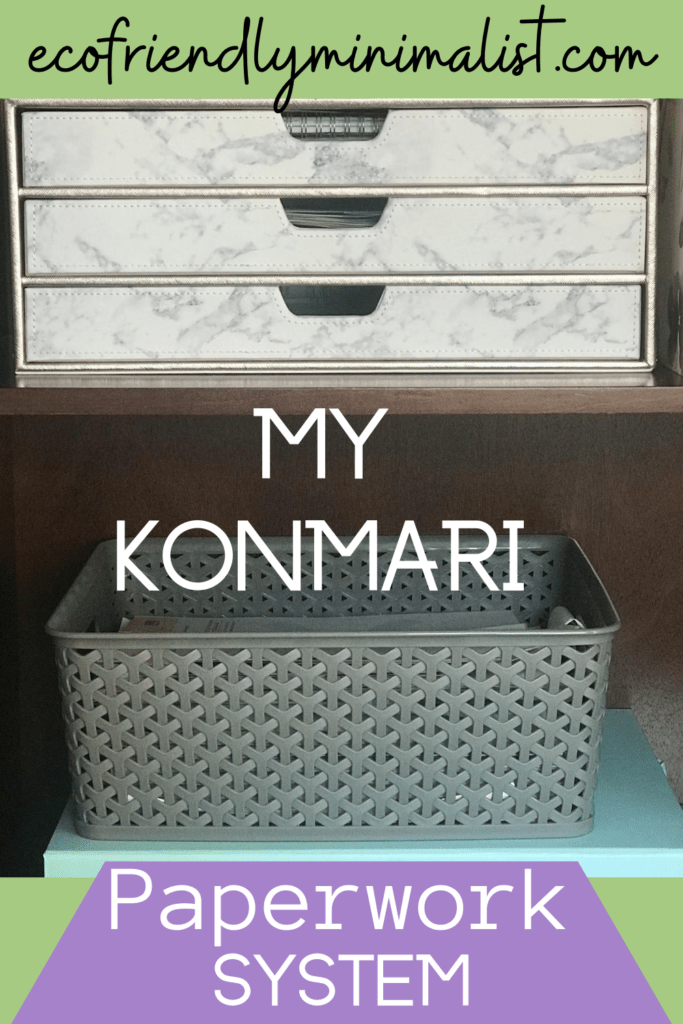
I moved this simple paperwork system to my bookshelf in my living room. This way, it is easily managed daily.
I have (nearly) acheived that goal but the paperwork is still piling up, and still overwhelms me.
But, everybody’s life is different.
I have a lot of people in my family and a lot to manage.
Don’t let me discourage you from trying the KonMari paperwork system.
For me, reducing books was the easiest category, followed by clothing.
But, I didn’t exactly follow all of the rules. I left the “no joy” pile of clothing in a corner of my room behind a chair, mainly because I was worried that I might need something that I tossed away.
After a month, I only went to the pile once. So, I think that is a success.
I have loved the ease of taking care of my clothing since doing the KonMari Method.
As for my books, I haven’t looked at any of my books at all! BUT, I still like the idea that I have them if I want them AND I have the space for them.
So, in ending, I hope this article will help you on your path to creating more simple daily household systems and will inspire you to start with clothing, books, and paperwork.
Thanks for coming on this wild ride with me!
And, please, leave a comment! I’d love to hear your story.
